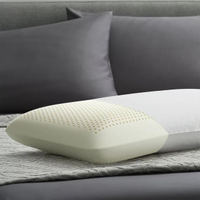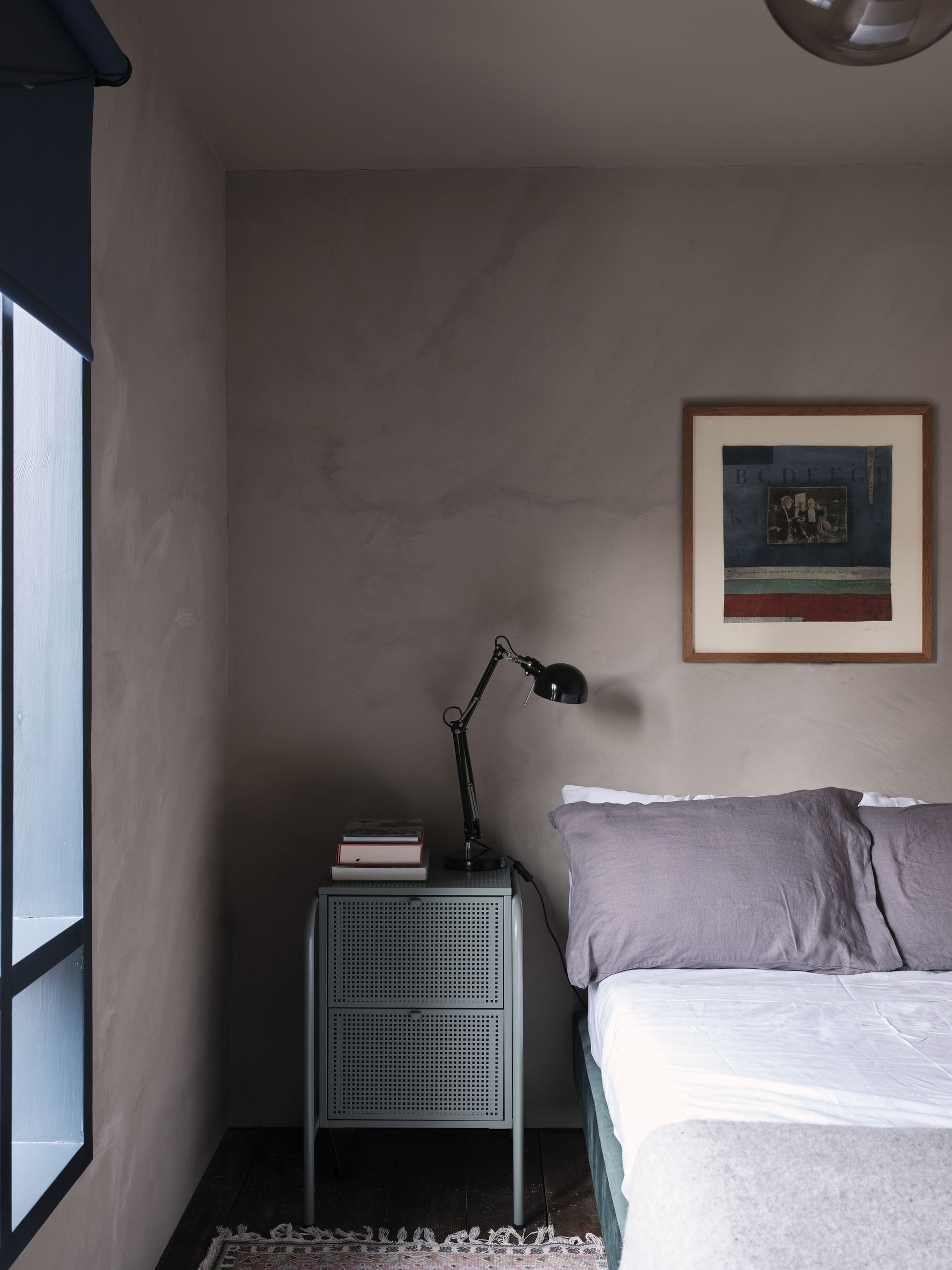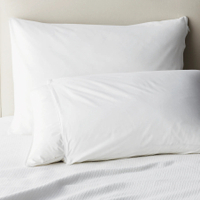How often should you replace pillows? Experts explain why going too long can be bad for your sleep
Plump pillows promise both better sleep and posture. Here's how often you should replace pillows for healthy sleep according to experts


You can go years without considering how often you should replace the pillows on your bed, but it's important. If there's one thing we all value, it's a good night's sleep. Besides restoring our energy levels, a comfortable snooze in a cozy bed is vital for our posture, and knowing how often you should replace your pillow is key to promoting that. And yet, the chances are that you're not switching them up regularly enough...
Since a third of your life is spent with your head resting on a pillow, it's important that this soft sleep supporter is benefiting your body. Not only are they associated with a more blissful slumber, but using a pillow helps align your spine to alleviate neck and back pain. Over time however, the material filling inside your pillow wears down making them flat and misshapen.
As a result, sleep coaches and bedding experts always encourage you to frequently replace your pillows, although most of us don't buy new ones nearly half as often as we should. To understand just how regular this routine should be, and help you choose the best pillows to support your sleep, we asked some professionals in the know for their insight.

Lilith is an expert at following news and trends across the world of interior design. She's committed to helping readers make the best choices in their homes through sharing practical tips and innovative solutions for a happier, healthier space. For this piece she asked bedding experts for their insight on how often your should replace a pillow for the best night's sleep possible
How often should you be replacing your pillows?

When was the last time you treated yourself to new pillows? Let's face it, we're all guilty of leaving our mattress or duvet on our beds for too long, and the same goes for our pillows. After all, they don't come cheap! If you've purchased new pillows in the last two years you're probably okay for a while, but any longer and you might want to consider an upgrade.
Of course, the amount of usage and the material your pillow is made from will play a part but as a general rule of thumb, you should replace them every one to two years to promote better sleep. 'A high-quality pillow should last around five to seven years while more budget alternatives may need replacing much more frequently,' says Stephen Light, certified sleep coach and CEO of Nolah Technologies.
How does the pillow's material affect this?

If you travel regularly or sleep across different properties, your pillows will probably last longer since you're not using them as frequently. However, the main factor affecting the lifespan of your pillow is the material it's made from.
'Polyester or down alternative pillows tend to last between one or two years and can start to get a little lumpy in spaces after this,' notes James Higgins, sleep specialist and CEO of Ethical Bedding.
High-end pillows on the other hand are typically longer lasting, making them a worthy investment despite the price tag. This is because they're made with more durable materials like latex, high-resilience foam, or natural feathers.
'Latex pillows have high elasticity and adapt precisely to the neck and head,' explains Po-Chang Hsu, Medical Content Expert at SleepingOcean. 'Since latex pillows have small openings in the filling, they are better ventilated, which also affects the lifespan of the pillow.' According to Pho-Chang, they should last at least two years.
While memory foam pillows are often considered more supportive, hence their use within travel pillows, the strength of the material decreases over time and should therefore be replaced every one to two years.

Latex Foam Mid-Loft Pillow 2-pack, from Walmart
Sleep soundly knowing that your pillow is not only sustainable, but responsive and supportive no matter your sleeping position. This springy latex pillow also has a ventilated design to help regulate your temperature, minimizing sweat and discomfort. Win-win!
How do you know when you need a new pillow?

Besides the age of your pillow, there are a few signs you should look out for to help decide if it's time for a new one. The first is general wear and tear. 'It’s time to consider investing in new pillows when they begin to feel lumpy,' says James. 'When it's a little low with a loss of spring, this means the fabric has become overused and worn down.'
Alongside losing its shape, you'll probably start to notice some physical discomfort, too. 'If you are waking up with a sore neck, or finding it hard to find a comfortable sleep position, that could be a sign that your pillow is not providing the support you need and could be a sign to replace it,' says Jeremy Klein, Product Expert at SleepFoundation.
There are also the potential implications of an old pillow. Ever noticed that your pillow is discolored when changing your sheets? Well during our sleep we sweat more than you'd like to believe. 'With pillows, moisture is a common cause of bacteria buildup,' Stephen says. 'If your pillow feels damp, has serious stains, or has an odor, it’s time for a replacement.'

Natural goose down feather pillows, from Amazon
For an extra fluffy feel, opt for natural, ethically-sourced down feather pillows and reap the benefits of a more blissful slumber (we guarantee they'll have you hitting snooze for an extra ten minutes). These ones use a double fabric lining to prevent the feather filling from sticking out.
What are the risks of not changing your pillow?

With those prompts in mind, it's no surprise that a pillow that's seen better days won't be benefitting your health. 'If you leave it too long to change your pillow it can cause neck strain as there is not enough support for your head throughout the night,' explains James. Not only can this damage your posture, but it will likely interrupt your sleep, too.
What's more, bedding can affect our skin. A dirty pillow that hasn't been changed in several years will begin to harbor plenty of dust and bacteria that can cause problems. According to Jeremy: 'If you don't regularly switch out your pillows, face breakouts and allergies can become more prevalent.' If you've noticed spots on your skin or allergy flare-ups, consider ditching your old pillow and see if you notice a difference.

Cotton pillow protector, The Company Store
Keep your pillow fresh for longer using a cotton pillow protector. This extra barrier will prevent sweat, dirt and dead skin cells from penetrating into your pillow's inner filling so you won't have to replace it as regularly. Good for your pocket and the planet!
How to prolong the longevity of your pillow
If this news has dampened your mood, you might be pleased to hear there are several ways to prolong the lifetime of your pillow.
Firstly, it's a good idea to invest in a pillow protector as these act as a barrier that stops body oils and dirt burrowing into the inner filling of your pillow. 'Another thing you can do is wash your pillows every three months to increase their lifespan,' says James. 'It’s important to check the care label and the manufacturer’s instructions on how to best do this for the filling you have, but this will help keep the filling hygienic and bring back the spring in the fabrics.'
'A built-in cover also goes a long way to preserving a pillow,' adds Stephen. 'For example, Nolah’s Squishy Pillow features a removable and machine-washable bamboo blend cover that wicks away sweat, keeping the pillow dry.'
There's a lot to digest but one thing's for sure, we'll be taking a trip to our nearest home store for new pillows this weekend.
Be The First To Know
The Livingetc newsletter is your shortcut to the now and the next in home design. Subscribe today to receive a stunning free 200-page book of the best homes from around the world.

Lilith Hudson is the News Editor at Livingetc, and an expert at decoding trends and reporting on them as they happen. Writing news, features, and explainers for our digital platform, she's the go-to person for all the latest micro-trends, interior hacks, and color inspiration you need in your home. Lilith discovered a love for lifestyle journalism during her BA in English and Philosophy at the University of Nottingham where she spent more time writing for her student magazine than she did studying. After graduating, she decided to take things a step further and now holds an MA in Magazine Journalism from City, University of London, with previous experience at the Saturday Times Magazine, Evening Standard, DJ Mag, and The Simple Things Magazine. At weekends you'll find her renovating a tiny one-up, one-down annex next to her Dad's holiday cottage in the Derbyshire dales where she applies all the latest design ideas she's picked up through the week.
-
 These 12 Best Table Lamps for Your Desk — Perfect Glows for a Creative Home Office
These 12 Best Table Lamps for Your Desk — Perfect Glows for a Creative Home OfficeThe best table lamps for your desk is have a soft, targeted glow. Elevate your WFH set-up with these stylish picks endorsed by Style Editor Brigid Kennedy
By Brigid Kennedy Published
-
 The Nespresso VertuoPlus is 30% Off for President's Day, and it's Kim Kardashian's Coffee Maker of Choice
The Nespresso VertuoPlus is 30% Off for President's Day, and it's Kim Kardashian's Coffee Maker of ChoiceThis sleek and stylish coffee maker was spotted in Kim's home bar, and you can currently save $60 if you buy yours from Amazon
By Lilith Hudson Published

